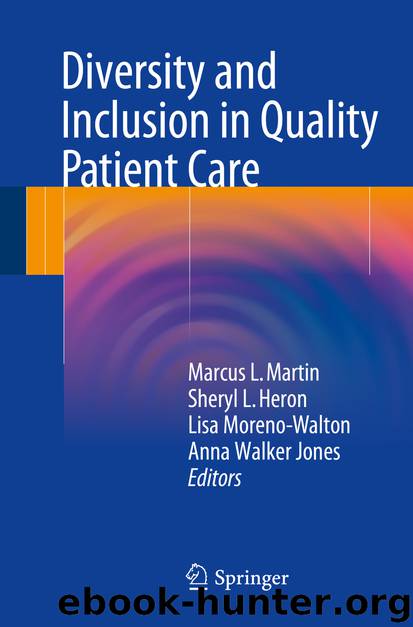Diversity and Inclusion in Quality Patient Care by Marcus L. Martin Sheryl L. Heron Lisa Moreno-Walton & Anna Walker Jones

Author:Marcus L. Martin, Sheryl L. Heron, Lisa Moreno-Walton & Anna Walker Jones
Language: eng
Format: epub
Publisher: Springer International Publishing, Cham
Discussion
The physically disabled may present to emergency departments for a number of reasons: their visit may involve an injury or medical condition that is the cause for their newly diagnosed disability; they may have a new medical problem related or unrelated to the disability; or they may have a problem which requires a primary care practitioner but do not have a “regular” doctor. In any event, the emergency department (ED) staff need the necessary skill set to assess and treat the physically disabled person with appropriate dignity and medical skill.
Infrastructure and equipment should be suitable for those with impaired mobility or using assistive devices. Doors and bathrooms should be wheelchair accessible , and additional hand railings and large flush handles and taps should be available [6]. Staff should be available to assist the physically disabled to mobilize when they need to, and to assist with specific tasks if help is required. Those who are hard-of-hearing should be offered written alternatives of information or questions, and signage should be clear and in large print with good colour contrast, to enable the partially sighted to find their way around. Brightly coloured or contrasting coloured floor tiles or coverings should be employed to clearly demarcate areas for the partially sighted [6]. Floors should be non-slip and have no raised joins or seams [6]. If required, an escort or family member who may assist with translation and movement around the department should accompany the patient. Those with indwelling catheters or stoma bags sho uld have access to the appropriate care for these items.
The internationally accepted symbol of accessibility (usually a line drawing of a person in a wheelchair within a square) should be clearly displayed at all entrances/ramps/toilets specifically designed for wheelchair or other device accessibility . Corridors, bathrooms and rooms should be wide enough to allow wheelchairs to pass through and to turn around. Ramps at entrances should be clearly marked for wheelchair access and should have adequate hand railings for grip [6].
In acute illness or injury that may cause disability, appropriate emergency management and early referral to the appropriate inpatient specialty are essential. In the case of medical illness causing disability (for example stroke or acute myocardial infarction), early and aggressive supportive and resuscitative management should be instituted to prevent morbidity and mortality [7, 8]. Simple “ABC” measures like appropriate fluid administration, airway management and invasive/non invasive ventilator support will prevent further deterioration before admission. In the case of injuries, whether from large road traffic accidents, or smaller interpersonal violence incidents, a structured approach of a primary survey, followed by a comprehensive secondary survey is required. Early wound closure, sufficient fluid management, aseptic technique and appropriate use of blood products, along with early operative interventions if required will prevent complications that may cause or worsen disability [9, 10]. Neurovascular examinations should be meticulous and documented clearly, particularly if any local anaesthetic or sedative agents are to be given. The patient and/or family should be counselled honestly regarding the illness or injury, and the potential outcomes and prognosis.
Download
This site does not store any files on its server. We only index and link to content provided by other sites. Please contact the content providers to delete copyright contents if any and email us, we'll remove relevant links or contents immediately.
| Administration & Medicine Economics | Allied Health Professions |
| Basic Sciences | Dentistry |
| History | Medical Informatics |
| Medicine | Nursing |
| Pharmacology | Psychology |
| Research | Veterinary Medicine |
Good by S. Walden(3488)
The Social Psychology of Inequality by Unknown(2940)
0041152001443424520 .pdf by Unknown(2784)
The Checklist Manifesto by Atul Gawande(2779)
The Meaning of the Library by unknow(2505)
Guns, Germs and Steel by Diamond Jared(2303)
Borders by unknow(2229)
23:27 by H. L. Roberts(2197)
And the Band Played On by Randy Shilts(2129)
Get What's Yours for Medicare: Maximize Your Coverage, Minimize Your Costs by Philip Moeller(2098)
Being Mortal: Medicine and What Matters in the End by Atul Gawande(2085)
A Leg to Stand On by Oliver Sacks(2005)
The Hot Zone by Richard Preston(1983)
The Valachi Papers by Peter Maas(1814)
The Laws of Medicine by Siddhartha Mukherjee(1755)
The Andromeda Strain by Michael Crichton(1696)
The Obesity Epidemic by Robyn Toomath(1646)
Pharmacy Practice and The Law by Richard Abood(1543)
Autism's False Prophets by Paul A. Offit(1496)
